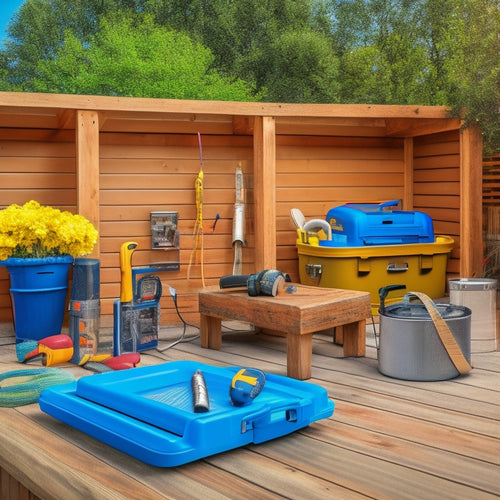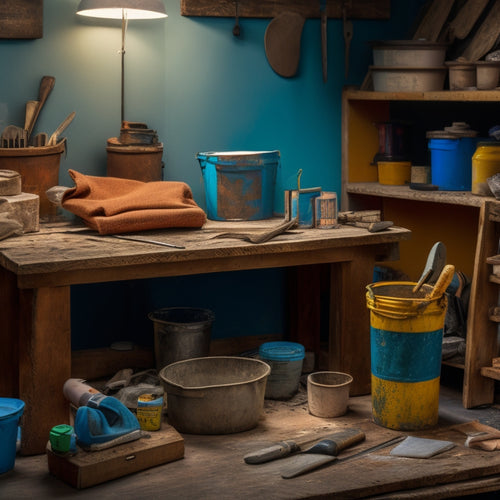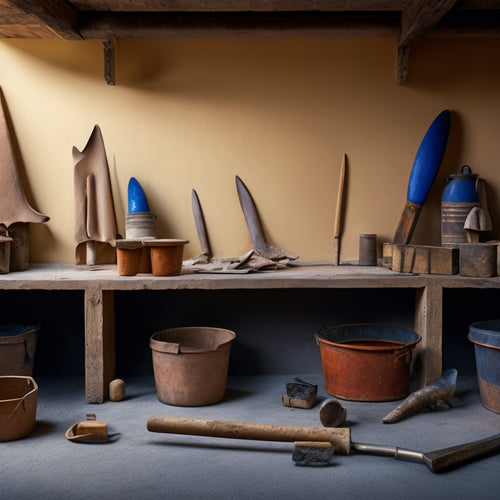
Why Choose the Right Saw for Home Renovation
Share
When tackling a home renovation project, you need the right saw to guarantee success. Choosing the correct saw depends on the type of concrete, cutting technique, and project scope. Walk-behind saws are ideal for large-scale projects, while handheld saws suit smaller tasks. Circular saws offer versatility, but prioritize maintenance for peak performance. Consider key features like diamond or abrasive blades, motor power, and cutting depth requirements. By selecting the right saw, you'll make precise cuts, save time, and stay within budget. Now, take a closer look at your project's specific needs to find the perfect saw match.
Key Takeaways
• Choosing the right saw for home renovation projects ensures efficient and precise cuts, saving time and effort.
• The correct saw selection prevents damage to the saw and material, reducing waste and costs.
• Using the right saw for the job type and material improves safety by reducing the risk of accidents and injuries.
• The right saw choice contributes to successful and efficient renovations, enhancing overall project quality.
• Selecting the appropriate saw type and features prevents frustration and ensures a professional-looking finish.
Understanding Your Concrete Needs
Determine the type of concrete you'll be working with, as this will greatly impact the saw you choose, since different saws excel at cutting through varying concrete densities and compositions. Are you dealing with high-strength concrete, regular concrete, or perhaps fiber-reinforced concrete? Each type requires a specific cutting technique and saw design. For instance, high-strength concrete demands a saw with a more aggressive blade and higher power output to effectively cut through its dense structure.
When evaluating concrete types, consider the aggregate size, compressive strength, and any additives present. This information will help you select the ideal saw for your project.
You'll also need to think about the cutting techniques you'll employ. Will you be making straight cuts, curved cuts, or demo cuts? Different saws are better suited for specific cutting techniques, so it's crucial to understand your concrete needs before making a purchase. By doing so, you'll guarantee you're equipped with the right tool for the job, resulting in efficient and precise cuts.
Best Concrete Saw for Home Renovation Projects
With your concrete needs clearly defined, you can now narrow down your search to the top-rated saws specifically designed for home renovation projects, such as walk-behind saws, handheld saws, and circular saws.
Each type of concrete saw has its unique features and advantages, making it vital to choose the right one for your project. Walk-behind saws are ideal for large-scale projects, offering more power and stability. Handheld saws, on the other hand, are perfect for smaller tasks and tight spaces. Circular saws provide versatility and are suitable for both small and large projects.
Regardless of the concrete saw type you choose, proper maintenance is important to guarantee peak performance and extend its lifespan. Regularly clean the saw's air filter and water reservoir to prevent clogging and corrosion.
Lubricate the blade and other moving parts to reduce friction and wear. Additionally, inspect the saw's cord and plug for damage and replace them if necessary.
Key Features to Look for
As you narrow down your options, reflect on the specific features that'll make a concrete saw suitable for your home renovation project, taking into account factors like blade type, horsepower, and cutting depth.
When it comes to blade types, you'll want to decide between a diamond blade or an abrasive blade. Diamond blades are ideal for more precise cuts and are suitable for most renovation projects, while abrasive blades are better for rough cuts and removing old concrete.
Motor power is another vital feature to evaluate. A saw with higher horsepower will be able to handle tougher materials and make cuts more efficiently. However, it'll also increase the weight and cost of the saw.
Think about the type of material you'll be working with and the size of the cuts you need to make when choosing the right motor power. Additionally, consider the cutting depth you require, as this will impact the saw's ability to make precise cuts.
Safety Precautions and Tips
Operating a concrete saw can be hazardous, so it's crucial you take necessary safety measures to protect yourself and others around you from flying debris, dust, and noise.
Wearing personal protective equipment (PPE) such as safety glasses, ear protection, and a dust mask is a must. Confirm you're wearing sturdy boots, long pants, and a long-sleeved shirt to prevent cuts and abrasions. Keep loose clothing and jewelry tied back to avoid entanglement with the saw.
Maintain your saw regularly to verify it's in good working condition. Check the blade for damage or wear, and replace it if necessary. Keep the saw clean and well-lubricated to prevent overheating. Regularly inspect the power cord for signs of wear or damage, and replace it if necessary. Always follow the manufacturer's instructions for tool maintenance and operation.
When operating the saw, maintain a firm grip, and keep your body positioned away from the blade. Avoid overreaching or applying excessive pressure, which can cause loss of control. Keep bystanders at a safe distance, and never let children operate the saw.
Making the Right Choice Matters
You'll be faced with a multitude of saw options when gearing up for your home renovation project, and selecting the right one can make all the difference between a successful outcome and a costly mistake. The wrong saw can lead to inaccurate cuts, wasted materials, and even safety hazards. To avoid these issues, it's crucial to evaluate the project scope and the type of cuts you need to make.
Different saw types are designed for specific tasks, such as rip cuts, cross-cuts, or miter cuts. For instance, a circular saw is ideal for making straight cuts in wood, while a jigsaw is better suited for curved cuts. A miter saw, on the other hand, is perfect for precise angled cuts.
By understanding the capabilities of each saw type, you can choose the right tool for your specific project needs. Take the time to research and compare different saw options, and don't be afraid to ask for advice from a professional if needed.
With the right saw in hand, you'll be well on your way to a successful and stress-free home renovation project.
Frequently Asked Questions
Can I Use a Saw for Both Concrete and Wood Cutting Projects?
You're wondering if you can use a saw for both concrete and wood cutting projects.
Well, the answer is, it depends on the saw type and cutting techniques you use.
You'll need a diamond blade saw for concrete cutting, as it's designed to handle abrasive materials.
For wood cutting, a circular saw or jigsaw will do the trick.
However, using the wrong saw for the job can lead to poor results and safety risks.
Choose the right saw for the task at hand to guarantee a successful project.
How Often Should I Maintain and Sharpen My Concrete Saw?
You'll want to maintain and sharpen your concrete saw regularly to guarantee peak performance.
Set aside time every 2-3 weeks to inspect and clean your saw, checking for worn or damaged parts.
When sharpening, use a diamond wheel or CBN grinding wheel to remove metal filings and maintain the blade's edge.
Additionally, apply saw maintenance tips like lubricating the blade and checking the arbor bearings to extend its lifespan.
What Is the Ideal Saw Blade Size for Most Home Renovation Projects?
Imagine yourself a master craftsman in ancient Greece, building a Parthenon-worthy abode.
Fast-forward to your modern home renovation project, where a saw blade's size matters. For most projects, you'll want a 7-1/4" or 8-1/4" blade.
When choosing, consider blade material: carbide-tipped for durability, high-speed steel for affordability.
Saw blade types also vary: rip-cut for wood, cross-cut for precision, and combo for versatility.
Pick the right one, and your renovation will be a masterpiece.
Are Electric or Gas-Powered Saws Better for Indoor Renovations?
When it comes to indoor renovations, you'll want to prioritize indoor safety.
Electric saws are generally a better choice since they produce less noise, vibration, and fumes compared to gas-powered saws. Their saw power is also more consistent, allowing for smoother cuts.
Plus, they're typically lighter and easier to maneuver in tight spaces. Opt for an electric saw with a high torque rating to guarantee efficient cutting and minimal kickback.
Can I Rent a Concrete Saw Instead of Buying One?
You're considering renting a concrete saw instead of buying one, and that's a smart move.
Concrete saw rental can be a cost-effective option, especially if you only need it for a small project.
Compare the rental cost to the purchase price and calculate how many times you'll use the saw in the future. If it's a one-time deal, renting might be the way to go.
Research local rental shops, and don't forget to factor in any additional fees or equipment requirements.
Conclusion
Without the right saw, your home renovation project can turn into a never-ending nightmare of broken blades, mangled materials, and mind-numbing frustration.
But with the perfect saw, you'll slice through concrete like a hot knife through butter, saving yourself hours, even days, of backbreaking labor.
The difference between success and disaster is that vital - so don't take the risk, choose the right saw for your project and watch your renovation dreams become a stunning reality!
Related Posts
-

Protect Your Tools for Outdoor Renovation Success
To guarantee outdoor renovation success, you need to protect your tool investment by understanding warranty and suppo...
-

DIY Plastering Supply Checklist for Home Renovation
To tackle a DIY plastering project for your home renovation, you'll need a solid checklist of supplies. Start with es...
-

7 Best Plastering Bat Sizes for DIY Renovations
When tackling DIY renovations, you'll want to choose the right plastering bat size to achieve a professional-looking ...


